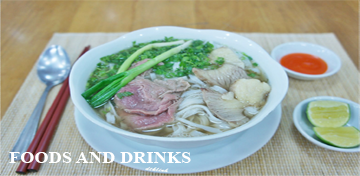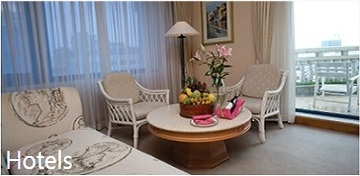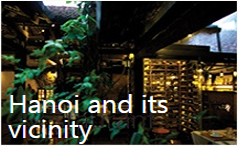Culture

Hanoi is convergence of dishes from different regions overall the country, however, the convergence here has to go through a careful filter of Hanoians which then it will be turned into a very specific style, very Hanoi, a Hanoi's Gift.
In Autumn 1010, King Ly Cong Uan moved the capital from Hoa Lu to Dai La and named the new capital as Thang Long. This was probably the time a new culinary style of the residents living in the land located in the center of 3 main rivers: Nhi Ha, To Lich, Kim Nguu started.
The ancients already have the saying: "Being close to river the first best policy, being close to the market the second best policy" which mentions about the favorable conditions of the residential area. Thang Long, Dong Do, Dong Kinh were the names given by the King to the capital city while Ke Cho was the folk name. Ke Cho is situated on the banks of Nhi, To Lich and Kim Nguu rivers where the wharfs and boats were always bustling and many kinds of specialties from other places were transported to here to make delicious cuisines for the capital city, Ke Cho gifts.
According to the historians, since the Ly dynasty there were already 4 big markets named the East, the South, the North and the West outside the 4 entrances of Thang Long Citadel. Moreover, there were many other markets, small shops selling gifts outside the city-gates which were the exchange areas between the inner, peri-urban and suburban areas.
In general, from the 10th to 18th - 19th Century, foreign trade had not been developed by Dai Viet's monarchies which may be due to the social security reason. Because of this, the gifts were mostly countryside and local gifts coming from "Four Protectors of Thang Long" regions, Northern Delta and beyond, everywhere in the country etc. Then, we do not know when the broad masses of people in Ke Cho had the proverb: "Sell mandarin oranges at the East market. Sell persimmons at the West market".
According to Le Quy Don (in Classified Sayings), the mandarin oranges in the East areas (Gia Lam, Dong Ngan and Co Loa) of Thang Long are very delicious while Bach Hac persimmons in the West areas (Viet Tri) of Thang Long have no seeds, crispiness and sweet taste. Because of this, the fruits have been indicated in the folk-song:
Let's try to select Vong green rice flakes
Select Bach Hac persimmons for me to be happy
Hence, it can be said that Hanoi is the place to gather, crystalize then nourish and spread. And in Hanoi's culinary culture, the familiar local gifts have become the gifts of Hanoi.
Thang Long – Ke Cho where has been urbanized, has many different ways to make the countryside gifts exquisitely to create the connoisseur characteristic of Hanoians. The city has also become a gathering place of exotic things and delicious dishes which are best selected from the cultural life. And the culinary has been ranked by the human being as in the saying: "the First is the imperial capital city, the second is Pho Hien"
As indicated above, at the beginning the gifts did not originate from Hanoi or other urban areas, it derived from agriculture villages. Because of this, gifts here do not only mean cakes but also eating, tasting, quick eating, trying dishes for the taste not for feeling full. Therefore, with a specific way of enjoying and preparing, the gifts are sotisphicatedly made based on the principle of using the ingredients on its season and at the right time.
Hanoians in the past and nowadays (except a small part of people moving to Hanoi to find a job) are not the "all-eater".
Hanoians who are considered as connoiseurs of food, have formed a unique style in culinary. The cookers here have always created a good impression by making the local-originated dishes be adaptable and famous.
Crab Noodle Soup is an example. This is a home-made gift bearing the special feature of the countryside in the North delta. However, when we eat the dish cooked by Hanoians, the connoisseurs still feel the difference because of the condensed crab soup with bright yellow color, spongy and soft crab roe, fragrance of fresh crabs and rice vinegar when pouring on a bow of white noodles, together with a salad plate consisting of banana flowers, perrila, lettuces which are cut in small pieces.
As correctly as the comments of To Hoai writer: "Whatever comes to Hanoi, Hanoians will receive it and turn it into their own one, a very special Hanoi". If anyone has a chance to admire Hanoians preparing the gifts, he or she will realize immediately the differences. Even if it is a normal dish not a specialty, it is prepared carefully, thoroughly with special acquisitiveness. Then, a normal dish like crab noodle soup of the North Delta will be enjoyed by connoisseurs in a "comprehensive" manner which uses all of the five senses: the bright yellow color of the soup, attractive colorful plate of salad, good smell of rice vinegar mixed with crab fragrance, sponge and soft crab roe, sapid and crispy salad. All of them are in harmony.
As said above, Hanoians are very carefully in eating, drinking and selecting dishes; therefore, the art of enjoying gifts of Hanoians seems to have principles which they rarely do incorrectly.
In a day, they enjoy the gifts in a special way and will not eat whatever available. For example, Chicken Noodle soup (Pho Ga), Beef Noodle Soup (Pho Bo), Beef Stewed in Wine Sauce Noodle Soup (Pho Sot vang) are defined as the ones for breakfast. Stirred or Saute Rice Noodle are often taken in the evening. Sticky rice, sticky rice with sesame (Xoi vung), sticky rice with mung been (Xoi xeo) …..are only sold in the morning. Kebab rice noodles (Bun cha), stew pork rice noodle (Bun gia cay) are opted for lunch. During the night, small dishes like Heart and liver porridge (Chao tim gan), van than noodle are selected for the supper as this is the time people relax and the food can digest easily.
The famous thin rolled cake - Thanh Tri rolled cakes (Banh cuon Thanh Tri) eating with cinnamon pork pate, rolled cakes filled with pork meat (Banh cuon nhan thit), rolled cakes filled with eggs (Banh cuon nhan trung ga) are all the dishes for breakfast as well as for the night. Then chestnuts, Spinach sticky rice balls are sold until the city turns off the lights.
Hanoians enjoys the gifts that are in harmony with the nature, the heaven, the earth and the climate to balance Ying and Yang. They will not eat whatever available or whenever they can. With the elegant lifestyle, they have the selective drinking and eating habit which create a difference from other localities that have the same culinary manner.
It is through the way of eating and drinking that we can realize the personal characteristic and exquisiteness in enjoying the food as it is demonstrated in every detail such as: the green sticky rice has to be wrapped in lotus leaves to maintain its smell, the softness through the humidity and to get the fragrance of lotus leaves.
Hanoians do not enjoy green sticky rice in the hot Summer or Cold winter but in Autumn when the weather is cool. They take it with fully ripe banana. The curved, yellow bananas with brown spots which are placed beside a pack of green sticky rice wrapped in green lotus leaves, tied with yellow straws and put in a white ceramic plate will make you feel the good smell, the sweetness, softness, buttery taste of Hanoi's gift.
Autumn is not only the season for enjoying green sticky rice with fully ripe bananas but the season of snail and duck dishes. It is the time that Hanoians like to enjoy a bowl of rice noodle with West Lake's snails. The snail soup, which has often been said to have no taste, become tasty, sweet, sour and spicy thanked to the craftsmanship of the cookers. Taking a bowl of snail rice noodles in the morning is not only to fill up the stomach but also to enjoy the taste, the color of the dish which is made by the skillful hands of the cookers.
Then the Autumn of snail rice noodles and duck rice noodle goes, the Winter nights come to Hanoi with baked maize, hot roasted chestnuts, fried pillow shaped cake (Banh goi), Fried breadsticks eaten with dipping sauce of sour, spicy, salty, sweet tastes and some green papaya pieces or chicken porridge (Chao ga) taken with pepper and chili powder.
The rice noodles, porridges or dipping sauces found in Hanoi gifts stores often have all the tastes; however, the craftsmanship is how to prepare it suitably per seasons or dishes. For instance, in Winter when the weather is cold and humid, the sour dishes should not be used so the sellers or the buyers will increase the spiciness to have the feeling of sweating. However, the spicy taste of Hanoi is appropriate and as unique as their behaviors. Hanoi is the gathering place for dishes from overall the country. However, when they come to Hanoi, they have to go through a careful filter of Hanoians to become a specific one, a very special Hanoi's Gift. Let's look at an old but simple and familiar gift of Hanoians as the evidence: Sticky rice: a very normal dish.
From early morning, many kinds of sticky rice can be found in Hanoi. However, the ones that Hanoians like most are corn sticky rice (xoi ngo), Mung Bean coated Sticky Rice (xoi vo), traditional sticky rice with mung bean and fried shallot (xoi xeo) etc. When eating, Xoi vo should be turned up then blended with mung beans that have been steamed, mashed, rolled into small balls and cut into thin slices and added with a little chicken fat to make it shining and greasy. If it is Xoi xeo, on top of the sticky rice should be covered with yellow thin layers of bean then brownish crunchy deep fried shallot, mixed with the greasy taste of fat. The preparation of Xoi ngo is nearly the same as Xoi xeo except a difference which is to add white, tasty and soft cooked corns.
Hanoi has so many traditional gifts that we cannot tell all. However, when mentioning about Hanoi's gifts, Pho should not be missed.
Hanoi Pho always comprises sufficient ingredients: Spring onion being cut into small pieces with coriander, water mint, spring onion dipped in boiling water, pepper and fresh chilly. The basil smell or bean sprouts are not suitable for Pho. Hanoi fresh rice noodles are made appropriately which are not thin or thick. The beef is boiled, taken out to make it cool then is horizontally cut into thin slices to have the soft, sweet taste and good flavor without being crushed or tough.
The spirit of Pho is the soup which is made of beef and pork bones, a little dried shrimps, peanut worms with the smell having the appeal. A familiar Pho soup pot of Hanoians is the combination of the integration between the Seas, the lowland areas and the mountainous area. When enjoying sweet-smelling bowls of Pho in Hanoi streets, may be few people can distinguish the different tastes of spring onion, ginger of the lowland; cardamom, star aniseed of the mountainous area and dried squids, peanut worms from the seas.
Chicken Noodle soup (Pho Ga) has similar preparing process like Beef Noodle soup (Pho Bo). The only difference is to replace beef with chicken and use only pork bones and add lemon leaves threads on top to make a special smell. The other dish of Hanoi that needs more ingredients is Vermicelli Noodle Soup with Chicken, Pork and Egg Recipe (Bun Thang). The dish needs dried shrimps, shrimp pasty, Vietnamese mint, giant water bug extract which all create a full taste of Hanoi's gift.
Among the gifts of Hanoi, we cannot miss the sweet soup (che), which is loved by most of people, especially women and children. Despite of the fact that, Hanoi sweet soup is a countryside product, it bears the capital city style which is gentle, diversified, generous and has natural smell.
Hanoi sweet soup is the Vietnamese one that has been improved and adjusted. For example, young rice sweet soup (Che com) is made of Vong young rice, sugar, Manioc flour, pomelo flower extract. Handling a bowl of young rice sweet soup, apart from the sweet and elegant taste, you will imagine about the days of March with white color of pomelo blossoms, the smell of rice young from rice fields in the countryside in Autumn.
In families that have many generations living in Hanoi, the principles of using spices for each dish and in each case have always been transferred from generation to generation, creating a specific cultural feature of the Capital city. In cold weather, expanded glutinous rice sweet soup (Che Ba cot) is cooked with ginger and hot sugar soup to keep warm for the body. Whereas, in Summer, Lotus seed filling tea (che long nhan) with the smell of pomelo flowers and Jasmine flowers is selected. With only a little spice, the dish contains the acquisitiveness in human's behavior that is in harmony with the heaven and the earth.
Like other human beings, Hanoians also need to drink water every day. Their only difference is what to drink, when to drink and drink with whom?
Hanoi's gifts under the drinking category are rather diversified, however, the most popular and normal one is tea (which is called tra in Vietnamese to distinguish with che). Before, there were many cafés that are similar to the countryside. Hanoians like to drink fresh tea (also called green tea). The green tea should be drunk when it is hot and the tea is good when it has bright yellow color.
Hanoians do not take much Nuoc voi (Cleistocalyx operculatus tea) though most of them still bear the features of countryside where Nuoc voi is rather familiar. However, some people who still love Nuoc voi are willing to prepare a hot pot of Cleistocalyx operculatus flower buds with the smell of Chrysanthemum.
Most of tea cafés in Hanoi sell dried tea (before it was called Chinese tea). Drinking tea in Hanoi likes "A quid of betel and areca-nut starts the ball rolling". People drink tea when they meet each other, even if they are not thirsty or when they are either happy or sad, when they say goodbye to someone; discuss about the business or wait for someone etc. Because of this, dried tea has become a popular drink in Hanoi.
If green tea started a long time ago, coffee just appeared in Hanoi in the French Colonialism time. Hanoians drink French-style coffee with coffee filter and do not like the noisy tea cafés, coffee cafés are often quite and pleasant. The guests seat silently to wait for the coffee drops falling from the filter or take chance to read a newspaper or talk quietly with their friends. Entering in Hanoi a coffee café, people may think that the life has ceased here as all of the animation and noisiness have been left outside. This may be a way to enjoy Hanoi's gifts.
Hanoi enters the 21st century, together with the market economic development and the hurry and pressing lifestyle of the industrialization time, European and American style fast foods have been included in the list of Hanoi's gifts. It is not because of this, Hanoi's gifts will be forgotten as according to a natural principle: the more modern the life is, the more people want to come back to the primary one. Furthermore, the culinary tradition of Vietnam has expressed the full concept of the balance between man and the earth and the heaven. And when people are attached to the nature, the tradition of eating and drinking according to season of Hanoians will last forever. Thang Long – Hanoi is attractive to people's spirit not only because of its natural beauty and spirit but also small but gentle habits in the culinary culture.
The fragrance of pomelo flowers in a bowl of sweet soup, the strong taste of Pho bowl in the morning, some pieces of green onion and purple basil in the night porridge bowl are small things but they contribute to create a Thang Long' flavor, a taste of Hanoi's gifts that make anyone who come will never forget.
(Theo Chinhphu.vn)




